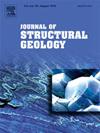孔隙岩石变形中剪切带方向的控制:改进微裂纹分割方法的启示
IF 2.6
2区 地球科学
Q2 GEOSCIENCES, MULTIDISCIPLINARY
引用次数: 0
摘要
高分辨率,时间分辨的x射线成像的变形过程揭示了前所未有的细节,微观结构和机械过程中涉及的系统规模失效在实验室实验中。这突出了不断发展的裂缝种群在控制局部化中的作用。然而,在多孔岩石中,由于裂缝的孔径狭窄,从岩石基质和预先存在的孔隙中准确分割演化的裂缝种群是具有挑战性的。在这里,我们开发并测试了一种新的全球统计方法来区分这三个阶段的层析切片,这些层析切片是在20mpa有效压力下对Clashach砂岩进行的x射线透明三轴压缩实验中获得的。与基于流域的方法相比,该方法在体素尺度(l≥40 μm)上对采样伪影的敏感性较低。此外,分段裂缝长度分布具有更大的动态范围,在150 μm以上屈服指数(1≤a≤3)与野外露头相同,裂缝取向分布的各向异性得到了更好的体现。利用这种新方法,我们观察到裂缝自发局部化成剪切带,其方向从随机分布演变为更有利于合成剪切和拉伸破裂的方向。观察到的剪切带方向(~ 60°倾角)介于定向渗流模型(50°)和剪切带中裂缝方向分布模式(66°)之间。本文章由计算机程序翻译,如有差异,请以英文原文为准。
Controls on shear band orientation in deforming porous rocks: Insights from improved microcrack segmentation method
High resolution, time-resolved X-ray imaging of deformation processes has revealed unprecedented detail on the microstructural and mechanical processes involved in system-scale failure during laboratory experiments. This has highlighted the role of the evolving crack population in controlling localisation. However, in porous rocks, accurate segmentation of evolving crack populations from the rock matrix and pre-existing pores is challenging because of the narrow aperture of cracks. Here we develop and test a new global statistical method of distinguishing between these three phases in tomographic slices, obtained from an X-ray transparent triaxial compression experiment on Clashach sandstone at 20 MPa effective pressure. Compared with a watershed-based method, the new method is less sensitive to artefacts of sampling at the voxel scale (l ≥ 40 μm). Furthermore, the segmented crack length distributions have a greater dynamic range, yielding exponents (1 ≤ a≤3) above 150 μm that are in the same range as those observed in field outcrop, while anisotropy in the crack orientation distribution is better represented. Using this new method, we observe the spontaneous localisation of cracks into a shear band, whose orientations evolve from a random distribution to one more favourably oriented for synthetic shear and tensile fracturing. The observed shear band orientation (∼60° dip) is intermediate between a directed percolation model (50°) and the mode of the crack orientation distribution in the shear band (66°).
求助全文
通过发布文献求助,成功后即可免费获取论文全文。
去求助
来源期刊

Journal of Structural Geology
地学-地球科学综合
CiteScore
6.00
自引率
19.40%
发文量
192
审稿时长
15.7 weeks
期刊介绍:
The Journal of Structural Geology publishes process-oriented investigations about structural geology using appropriate combinations of analog and digital field data, seismic reflection data, satellite-derived data, geometric analysis, kinematic analysis, laboratory experiments, computer visualizations, and analogue or numerical modelling on all scales. Contributions are encouraged to draw perspectives from rheology, rock mechanics, geophysics,metamorphism, sedimentology, petroleum geology, economic geology, geodynamics, planetary geology, tectonics and neotectonics to provide a more powerful understanding of deformation processes and systems. Given the visual nature of the discipline, supplementary materials that portray the data and analysis in 3-D or quasi 3-D manners, including the use of videos, and/or graphical abstracts can significantly strengthen the impact of contributions.
 求助内容:
求助内容: 应助结果提醒方式:
应助结果提醒方式:


